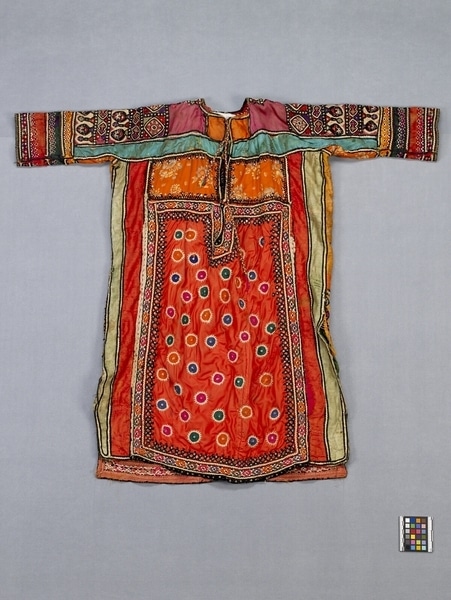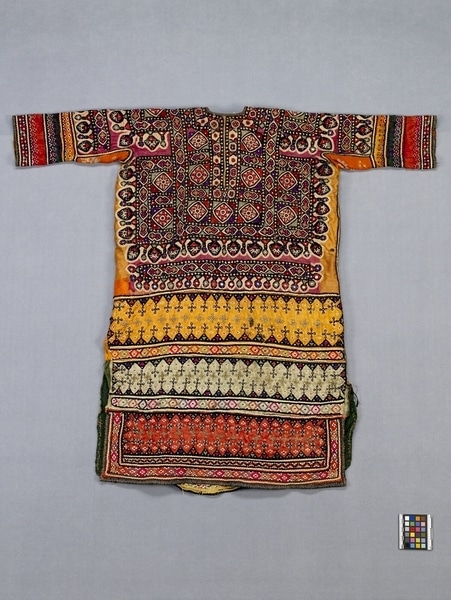Wedding Tunic Item Number: 1201/14 from the MOA: University of British Columbia


Description
Orange women’s tunic with embroidery and appliqué. The tunic has a high, square neckline. The front has a large embroidered panel from the shoulder to hip. The embroidery on this panel is so elaborately detailed and so densely worked that none of the background textile is visible, and this part of the tunic is very stiff. Within this panel are small- and medium-sized circular, diamond and double diamond shaped motifs arranged in rectangular groupings, and numerous very small mirrors. Below the panel are three horizontal panels of silk and cotton textile (yellow; light green; orange) embroidered with triangular, diamond and floral border designs worked in black thread, accented with several colours and metallic thread. The back of the tunic has a centre back opening with braided ties. Pouches made of orange silk textile and containing small amounts of dried plant material are sewn into the top edge on both sides of the neck opening. On the back there is a large panel of orange nylon(?), embroidered with multicoloured circular medallions and edged with diamond shaped border motifs, silver coloured sequins and white rickrack. Strips of light green and orange silk textile, edged with black braid and white rickrack, form side panels that connect the front and the back of the garment. The front of the tunic is slightly longer than the back. The sleeves are elbow-length and close fitting, made of bands of silk and cotton textile (orange; red; dark green; yellow) embroidered with cross stitch and decorated with sequins, braid and rickrack. All panels, strips and bands are underlined with cotton textile. A label made of off-white cotton textile, printed with a rubber stamp and handwritten with ball-point ink, is attached at the neck edge on the front with a loose running stitch.
History Of Use
Worn by the bride at her wedding, then daily until it wears out. After that, salvageable parts are used to make other items, such as purses, cushion covers or door hangings. Wedding tunics are made by the bride’s mother, who begins the embroidery when a girl is born. She continues working on it until the wedding day, sometimes with the help of neighbors and relatives. Razia Ahmed states that “during the wedding ceremony the (neckline) slit is worn to the back, but after the marriage is consummated it is worn to the front. This is symbolic. After the wedding ceremony the slit is worn permanently to the back.” This type of tunic is worn with shalwars (baggy pants), usually made of susi, a special woven cloth made in Sindh. It is rare to see women wearing this type of tunic today. Many of the women who would have made them are now employed in the money economy and no longer have time to embroider, as in the past.
Specific Techniques
Many different embroidery stitches, including buttonhole stitch; double buttonhole stitch; cretan stitch; couching; satin stitch; cross stitch.
Cultural Context
ceremonial
Narrative
This garment was purchased by the owners of Terlingua, a retail shop in Calgary, from an agent or dealer in Kabul, Afghanistan, and exported to Canada from there. The tunic was offered for retail sale at Terlingua previous to its acquisition by the Museum of Anthropology.
Item History
- Made in Thando Bula Khan, Sindh, Pakistan before 1982
- Collected during 1982
- Owned by Alan Davidson between 1982 and February 24, 1987
- Received from Alan Davidson (Seller), Ruth Read Bequest (Funding source) and Museum of Anthropology Shop Volunteers (Funding source) on February 24, 1987
What
- Name
- Wedding Tunic
- Identification Number
- 1201/14
- Type of Item
- tunic
- Material
- cotton fibre, silk fibre, synthetic fibre, glass, silver alloy metal, plant and dye
- Manufacturing Technique
- embroidered, cut, sewn and appliqued
- Overall
- height 97.0 cm, width 110.0 cm
Who
- Culture
- Lohana, Pallari and Burati
- Previous Owner
- Alan Davidson
- Received from
- Alan Davidson (Seller), Ruth Read Bequest (Funding source) and Museum of Anthropology Shop Volunteers (Funding source)
Where
- Holding Institution
- MOA: University of British Columbia
- Made in
- Thando Bula Khan, Sindh, Pakistan
When
- Creation Date
- before 1982
- Collection Date
- during 1982
- Ownership Date
- between 1982 and February 24, 1987
- Acquisition Date
- on February 24, 1987
Other
- Item Classes
- textiles
- Condition
- fair
- Accession Number
- 1201/0014